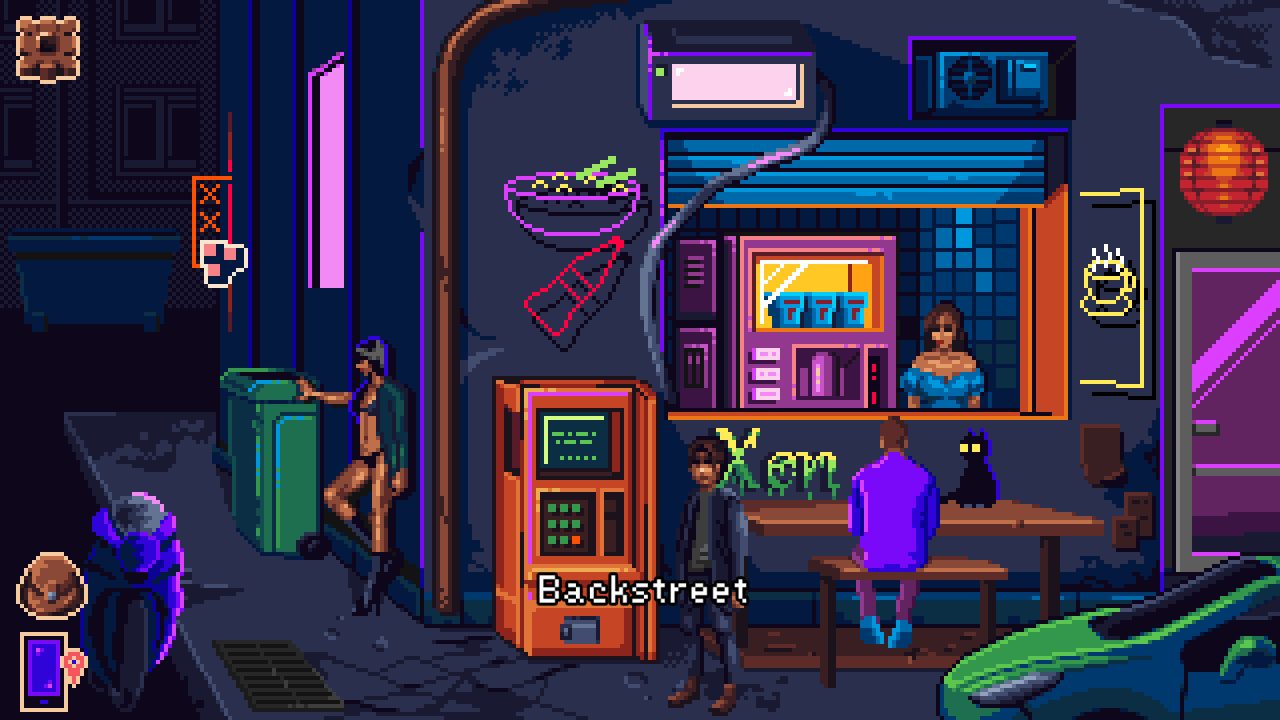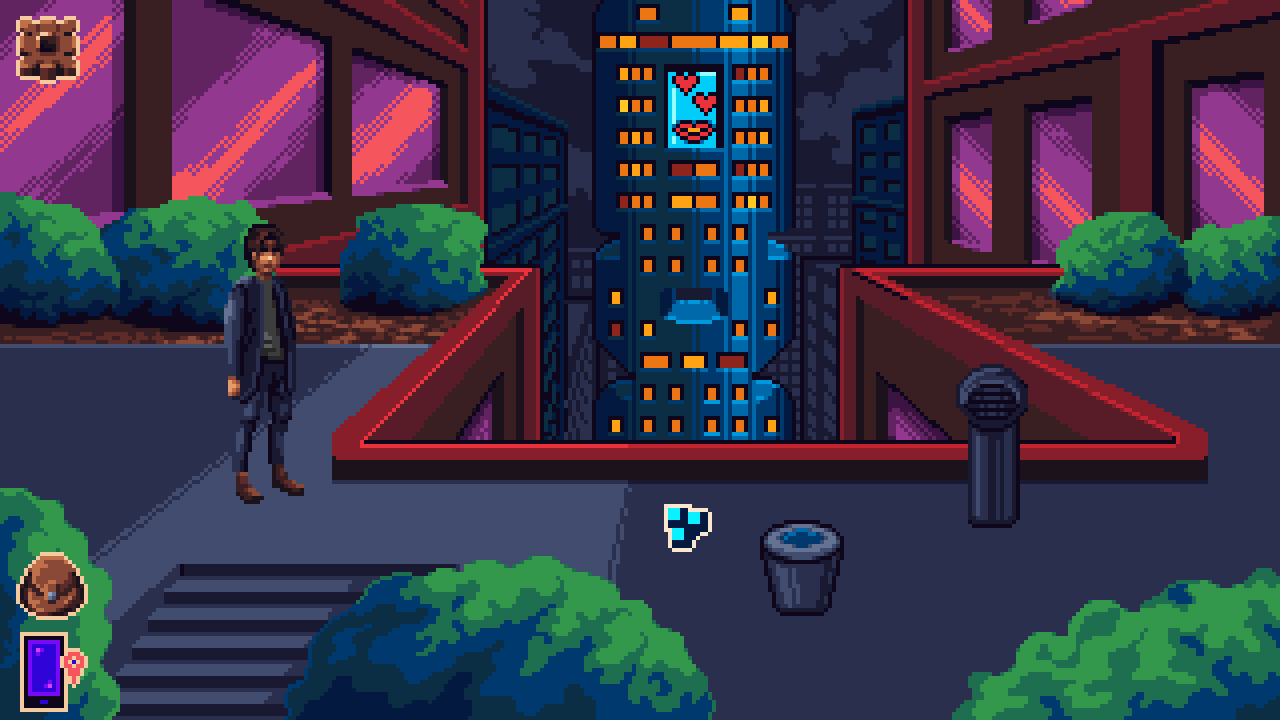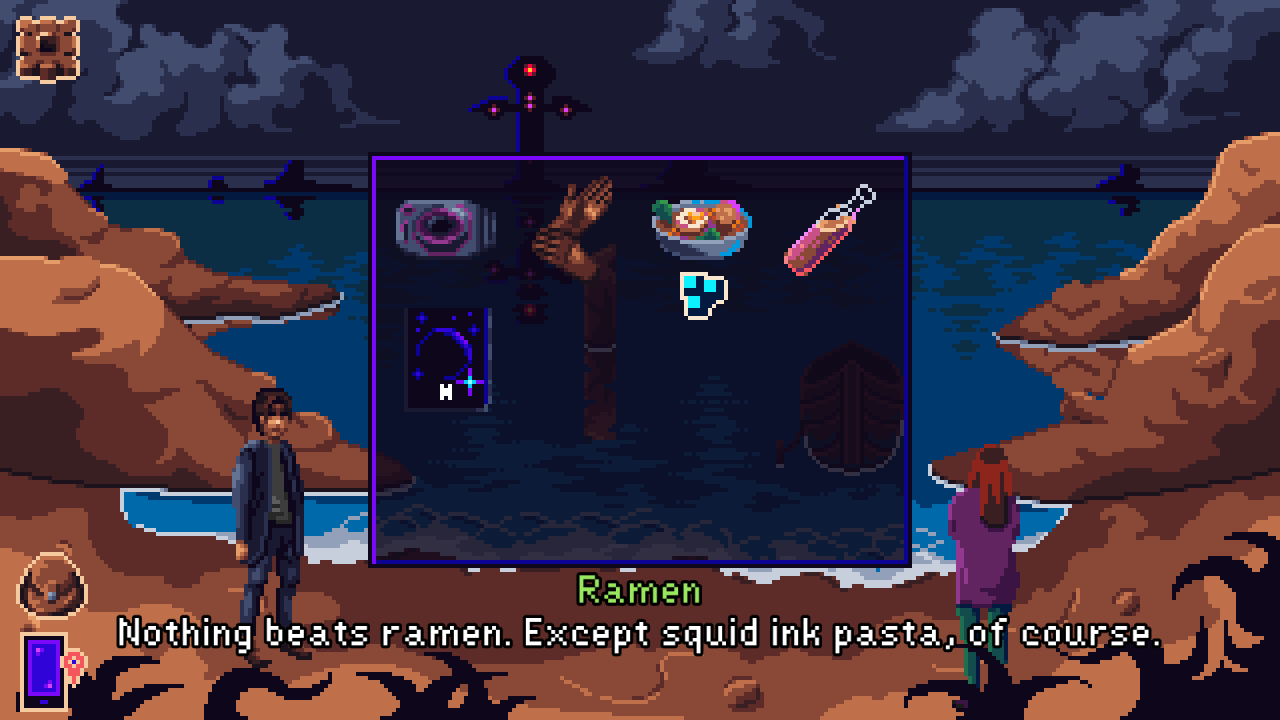Like greasy rain running down the window of a mega-city ‘scraper, caught in the illuminated neon hues of blocks-wide advertisement billboards, Neon Hearts City settles comfortably into a cyberpunk setting inspired by Dick, Pondsmith, and Gibson, with a healthy dose of LucasArts point-and-click adventures for good measure. The story is short, and the puzzles won’t test your intelligence (or patience) greatly, but the earnest sense of setting and evocative soundtrack do enough to tempt you into this futureworld mystery and see it through to its conclusion.
Neon Hearts City‘s set-up begins with a missing person case, with Elijah Crow (PI) taking the job to locate a young woman. This being a cyberpunk dystopia, Elijah soon discovers deeper connections between his missing person and the local android underground, the Ravens, as well as her involvement in the wider government’s monitoring of its citizens’ thoughts. Throughout the plot, the narrative roots itself in just about every cyberpunk and noir trope imaginable. Downbeat detective? Standoffish femme in distress? Dinky ramen hole-in-the wall? It’s exactly what you’d imagine it to be.
As the initial missing persons case develops, the story never veers too far from its personal focus and doesn’t explore the deeper concerns of Neon Hearts City. There are a few teasers of something greater lurking behind the setting: passing references to a Dark War, the existence of cyborg Chimeras, as well as a notorious prison housed in a giant, static airliner high above the city. But these glimpses are only that; nothing is expanded on, and the story only fleetingly mentions them. It would have been a real treat to explore Roark, this floating penitentiary, or actually set foot inside the high-security laboratories of Berwyn Tower, rather than just spend a single scene on its docks.
Like the best noir, Elijah is prone to poetic narration of the world through the lens of his despondent personal life, and this is done often enough on entry to a new location to become a key calling card of the themes of the game. These moments are not badly written, but further script development, or at least another few editing passes, would have trimmed some of the more egregious melodrama. The story also suffers from running out of steam towards the end, where it struggles to provide a decent payoff to the themes set up throughout the story.
Nevertheless, the tale is scripted earnestly, and the addition of full voice-over in Neon Hearts City is a welcome surprise in a genre not usually known for it. The performances are solid, and Elijah is imbued with enough charming cynicism to make him an engaging narrator throughout, whilst the other actors play their parts with a similar earnestness. It’s an impressive commitment for a game of this scope, and continues to reinforce Cosmic Void’s approach to their latest games.
Graphically, the pixel artwork uses bright, contrasting colors and simplifies the number of pixels on each object. Assets are large, with individual scenes containing maybe a half-dozen hotspots. It does have the effect of each scene becoming even more of a superficial milieu than usual in this genre. Each location, whether it be the shore, the comic book shop, or the fish market, can be understood in moments, with key details and objects bleedingly obvious against the simplistic backdrops. There’s no need or reason to pixel-hunt here, and there aren’t any intrinsic little details or effects contained in the scenes to add to the world or lore.
In every scene, the music vibes beautifully with the neon, dystopian backdrops. There’s little to raise a pulse or pound a retro rave into the skull, but there’s a bevy of slow synthwave progressions and electronic percussion sets to listen out for. Any one of them brings to mind some of the themes and feelings from seminal futurist soundtracks, even if they’re ultimately simple and short. There’s a respectable variety too, and credit to the developer, again, for committing to this level of detail.
Elijah moves around Neon Hearts City by selecting a destination from a cellphone icon, and additional locations become available as the plot progresses. The player controls interactions in the world through identifying hotspots in each scene. Unlike more frustrating examples, hotspots can be highlighted and cannot be missed. From these, Elijah will make observations about the world, or find an object or action he can take. These items are kept in his backpack inventory and can be selected (and combined) to try to interact with other hotspots or create new tools. The plot tries hard to set up a cohesive adventure and leave breadcrumbs in a logical manner. Yet some successes come from quite nonsensical combinations, or very nuanced environmental clues, where clicking frantically at hotspots or combining random items is the order of the day. To be fair, this is an issue known to most adventure games at some point, but Neon Heart City’s short length exacerbates the impact of some of the more confounding examples.
Cosmic Void mixes up the point-and-clicking with the addition of a few more varied puzzles. Some are simple riddles, requiring some basic wordplay or description, whilst a couple involve a graphical overlay for connecting circuits or for sliding panels over different areas in a marked grid. They add a little variety, but given how straightforward they are to complete, it feels more like a quick diversion from the story to add a little extra length and player agency. And it must be stressed Neon Hearts City firmly opts for narrative over player involvement.
On the one hand, it’s hard to know whether Neon Hearts City is a genuine attempt to carve the developer’s voice onto themes of personal identity and memory, or whether elements of the plot and game systems are designed to be more of a celebration: a nod to the ubiquity of cyberpunk and the questions it asks of humanity. Certainly, it’s not an original tale, either in plot or systems, and it sometimes seems to deliberately home in on every possible trope it can throughout its 2-3 hour duration.
Neon Hearts City is a tightly-designed adventure noir, with well-written dialogue and surprisingly heartfelt voice-overs. However, it struggles to make its voice heard in the vast continuum of cyberpunk futurism, and its systems are too familiar and simple to add any unique complexity to offset this. For those with a love of the subgenre, the honest graphics, thoughtful soundtrack, and nostalgic plot will grant a few sweet hours in a different reality. In the end, although all these moments will be lost in time, like tears in rain, it might be worth a visit to the City. Just remember to bring your raincoat, ramen noodles, and a healthy dash of cynicism.





